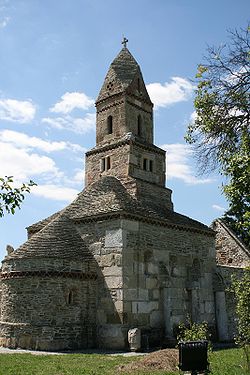- Densuş Church
-
The Densuş Church (also known as St Nicholas' Church) in the village of Densuş, Hunedoara County, Romania is one of the oldest Romanian churches still standing.
It was built in the 7th century with additions made in the 13th century on the site of a 2nd century Roman temple, with some materials from the Dacian Sarmizegetusa fortress. It has a stone tower above the naos. Inside the church there are 15th century mural paintings that show Jesus wearing Romanian traditional clothes.
It is considered that on the setting of the present day church, there was once a Dacian temple dedicated to Zamolxis, upon which the conquering Romans built a temple dedicated to the god Mars. After the Roman administrative withdrawal, the temple became a Christian church, and sermons were held there. Its present form dates from the beginning of the 12th century. Considering its tradition, it dates from the IV century AD, and is considered the oldest church in Romania and South East Europe, and historically its present form dates from the 12th century.
Hypothesis about Densuş
One of the hypotheses about Densuş is that it was once a pagan temple, and to sustain this argument, it is shown that: the altar of the church is closer to the South than to the East, which would suggest that it was once a pagan temple, because all Christian houses of worship have the altar pointing towards the East. Other clues are the form of the roof, which, seen from a lateral perspective, has the form of a bird, to be exact a dove, and above the altar there are two stone lions, united by their tails. Another hypothesis, based on inscriptions found inside the church, holds that it was originally built as a mausoleum to the Roman general Longinus Maximus.
The most widespread opinion is that the present Densus church was once a Christianised Roman temple, which is to say a Paleo-Christian church from the IV-VI centuries AD, and it is also the first church on Dacian territory. One thing is clear: the church was constructed on top of the ruins of a building dating from the 4th century AD, and it was constructed in several stages, the last one dating from the 13th century.
External links
- Ciprian Iancu, "Biserica Densuş, un templu românesc", Evenimentul Zilei, July 31, 2007
Categories:- European church stubs
- Romanian building and structure stubs
- Churches in Romania
- Hunedoara County
Wikimedia Foundation. 2010.


